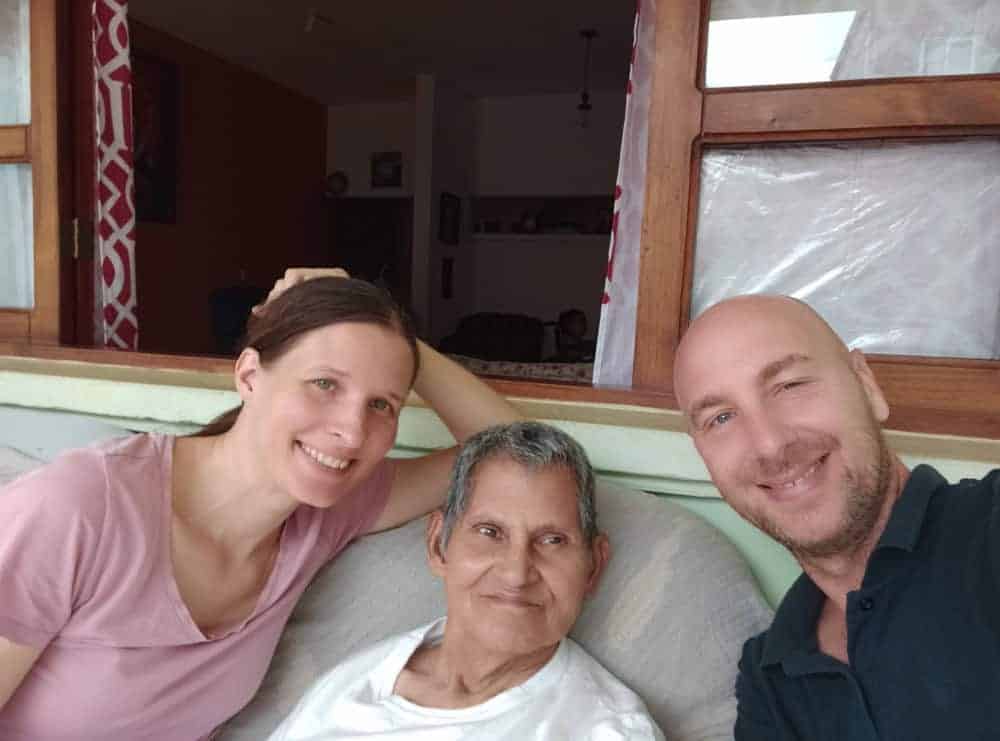If there’s one thing Hondurans love to discuss, it’s food. Due to the geographical diversity of Honduras, the cuisine varies significantly by region.
On the Caribbean coast, coconut milk, cassava flour, and spicy spices are staples. In the cooler mountainous areas, the diet includes hearty dishes, particularly grilled meats (carne asada) and a typical chicken soup.
In the interior, where we are, the fare is simpler but still very tasty, primarily based on beans, corn, vegetables, and of course, tortillas.
Everything revolves around tortillas
The first thing we learned to make in the Arc community kitchen was how to prepare tortillas.

If you are familiar with Mexican food, which is quite similar to Honduran cuisine, then you probably know about tortillas.
A crumbly dough is made from a mixture of water and either corn or wheat flour. Initially, egg-sized balls are formed. Using a metal press, these are then pressed into evenly thin, round tortillas.
They are quickly cooked on a special metal griddle without any oil or fat.
It sounds simple, but Silva and I spoiled quite a few before we managed to make them like they do here. Even though a tortilla is a relatively simple dish, it takes a lot of time to cook enough for an entire household, which means thirteen people, as we usually have at the table.
A few typical dishes
The tortilla is the basis for many other dishes that are part of the daily diet here. The most typical in Honduras, especially in the interior, is the baleada.
Baleadas are tortillas made from wheat flour. They are never made with the aforementioned press as they are larger than the corn ones. Once the tortilla is cooked, it is filled with mashed beans, cheese, and sour cream.

Another typical dish is tamales: a dough made from corn flour, filled with meat, vegetables, and spices, wrapped in banana leaves, and steamed.
The third dish, which we often prepare for our boys and girls, is casamiento. It consists simply of rice and beans mixed and cooked together.
No dish is complete without beans here. If Italians are known for pasta and Asians for rice, then Hondurans (and other Central Americans) are known for their beans.
It is not unusual for beans to be served in some form three times a day. They often complement meals as a spread, sometimes in tortillas, sometimes alone as a side dish.
So much frying!
Silva and I struggle the most with frying. We have never seen so much fried food consumed anywhere else. Our bodies often protest, and sometimes, we have to limit ourselves, as they are simply not used to so much oil and fat.

Sometimes, for lunch or dinner, instead of fried tortillas or tajadas (fried plantains), we eat just fruit, like melon, papaya, apples, or bananas. It’s unpleasant to stand out like this, but it’s necessary for our health.
Fruit is excellent but expensive
Fruit is delicious, of course, but it is less abundant than in South America. Due to the climate and lack of water, Honduras does not produce enough. A lot is imported. This is why it’s expensive, and some fruits cost as much as they would in Slovenia.

Perhaps this is also why fruit is hardly eaten in the community. It’s too expensive, and people here are not used to consuming raw fruit. They are accustomed to processed fruit, in desserts where the fruit is cooked and sugar is added, or in fruit juices, which also contain a lot of sugar.
Can’t do without sugar
We also avoid sugar here. There isn’t a natural drink sweet enough on its own that they wouldn’t add sugar to.
I feel they add it more out of habit than necessity because the drink wouldn’t be sweet enough. A disproportionately high number of Hondurans suffer from diabetes (among other diseases related to unhealthy eating).
In the community, they’re now used to it; when they prepare coffee or natural drinks for us, they don’t add sugar. It seems strange to them, but they are used to ‘quirky’ gringos who dislike fatty and sugary foods (we aren’t the first foreigners to help in the Arc community).
When you next make lemonade
Speaking of natural drinks, they showed us a fantastic method of making lemonade without squeezing lemons, which is ten times tastier. Actually, it’s not with lemons but limes.

Next time you want to make lemonade, take some limes and cut them in half. Put them in a blender and add some water. Blend them. Here, they advised us to run the blender for only fifteen seconds (we always count).
When blended, pour the mixture through a strainer into another container until only the larger pieces of lime remain on the strainer. Don’t remove them yet. Pour water through them and occasionally taste the drink to adjust the lemonade to your liking.
Chicken, pizza, and pancakes
Our boys and girls are not picky. They eat what we serve and always finish everything we prepare. Of course, they have their favorite dishes.
David loves pancakes, Hector chicken and mashed potatoes, and Darwin pizza. When we can afford it, we indulge them, and then they also help in preparation. For example, Hector, Johnny, and Mina peel potatoes when we make mashed potatoes.
Hector is so slow that we peel all twenty-five pieces while Hector is still on his first.
Bread the Slovenian way
Unfortunately, everything in the house is conditioned by finances. The food is simple because the house often cannot afford all the delights that would make the chicos happy.
We sometimes prepare meals for the community, of course, following Honduran recipes and instructions.

But what always delights our chicos is pizza or leavened bread, just like we always made it ourselves, the Slovenian way, with an old, homemade recipe.



